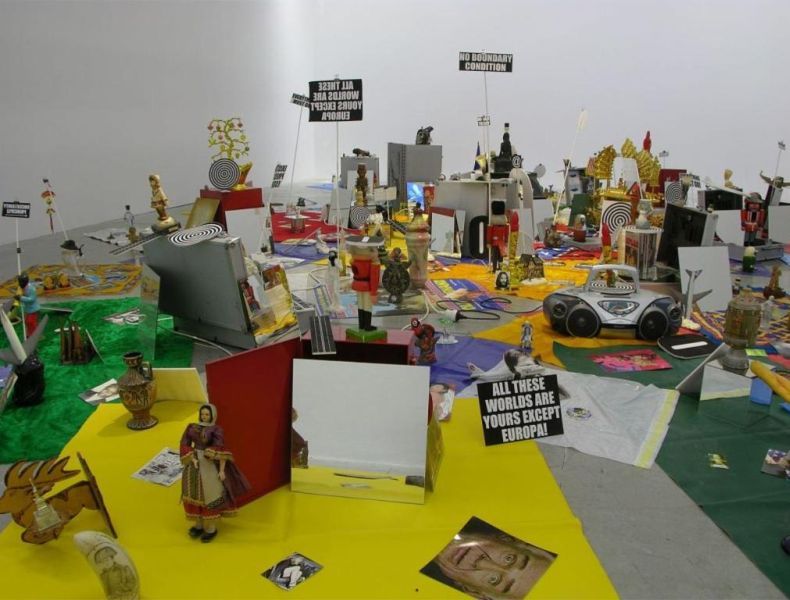Auckland Art Gallery News, March–June 2004.
Peter Robinson is one of the ‘young guns’, a new generation of contemporary Maori artists that emerged in the early 199os. Michael Parekowhai, Lisa Reihana, Jacqueline Fraser, Shane Cotton, and Peter Robinson all played a part in a decisive paradigm shift, collectively challenging a standing idea of contemporary Maori art formulated, practiced, and policed by the Tovey-generation artists and their followers. Robinson’s particular contribution was to attack the assumption that Maori art necessarily spoke from an earnest, worthy, aristocratic, spiritual position. Instead, his crass, shoddy-looking works paraded their lack of pedigree, their vulgarity. Looking like vernacular bogan-basement signage, his works were riddled with sales pitches, cheap shots, and tasteless taunts—they came as a shock to the system. Robinson’s work coincided with an international explosion in post-colonial identity art, and he soon found himself on the biennale circuit, his work providing an antidote to the worthy investigations that typified such shows. He became fascinated by the contradictions that nag at the utopian global art discourse, underpinned as it is by a multinational capitalism that is happily making the world smaller, eliminating difference. Our recent gift from the patrons, Robinson’s floor-based scatter installation The End of the Twentieth Century (2000) is a product of this enquiry.
At first glance, The End of the Twentieth Century looks glittery and brightly coloured, but closer inspection reveals the tragedy. This magpie’s nest is a slagheap of cheaply sourced tchotchkes and downloaded global bric-a-brac. A merger of exotica and cultural alienation, it takes in Bill-and-Monica Russian dolls; Belgian tourist poster-boy Tin Tin; a pornographic interracial love atlas; a golden Chinese junk; a reclining porcelain nude with detachable breasts—salt and pepper shakers; downloaded photos of transsexuals, aliens, scientist Stephen Hawking, and Marshall Applegate, the Heaven’s Gate cult leader; china clogs; camels; buddhas; model planes and skyscrapers … and much more! A TV screens the 1963 pseudo-anthropological round-the-world shockumentary Mondo Cane (Dog World), while Malcolm McLaren’s equally exploitive 1983 world music megamix Duck Rock blares out of a ghetto blaster. The ensemble is punctuated with Robinson’s own signs: a mix of instructions, warnings, inane slogans, bad jokes, and vortex graphics. Many are clipped to rods like political placards. Lengths-of-road graphics are scattered across the piece proposing routes for the eye, framing the bazaar as a kind of Lilliput landscape.
Wellington gallerist Peter McLeavey commissioned The End of the Twentieth Century as his last show of the century, and it could be seen, partly, as a rejoinder to another McLeavey artist, Richard Killeen. The piece was subsequently installed at the centre of Anna Miles’s 2001 Artspace show After Killeen, which was concerned with Killeen’s relevance to younger social-critic artists. Like a Killeen cutout, Robinson’s installation is a moveable feast that can be arranged in any order according to simple instructions. Like a cutout, it travels in suitcases (incorporated into the work as pedestals). But while Killeen presented the cutout as a new-age utopia—a democratic space in which each thing is granted equality and hierarchy is banished—Robinson’s radically deconstructed deregulated world is dystopian. It offers a more venal form of democracy, one familiar to anyone who has seriously surfed the net or partied in Vegas. Anything goes. The End of the Twentieth Century is a flea-market wunderkammer, a demented cultural core sample of world kitsch, a shambling tourist guide to bad globalism. If we were once concerned about the sensitivity of Maori souvenirs, The End of the Twentieth Century proves bad taste and cultural insensitivity are universal and epidemic. If the new art biennales epitomise feel-good globalism, this work dispels the illusion.
